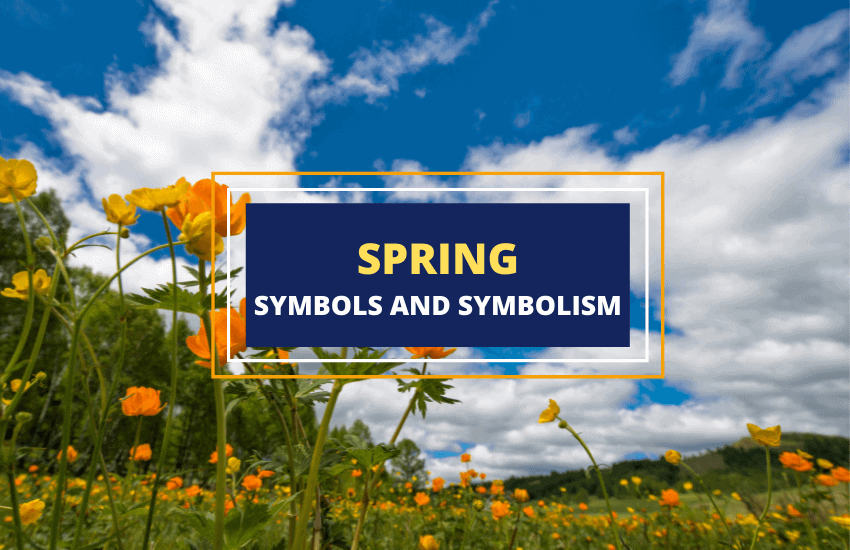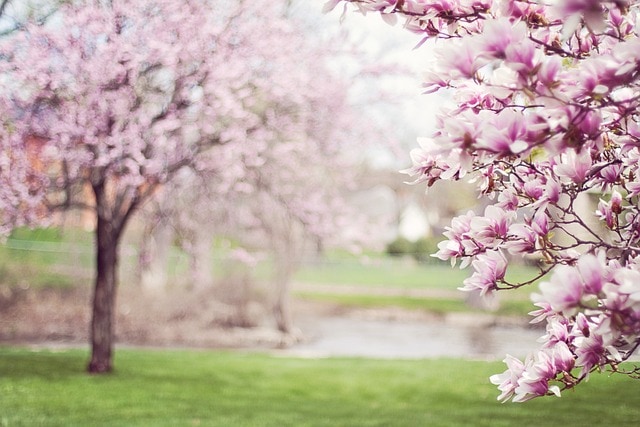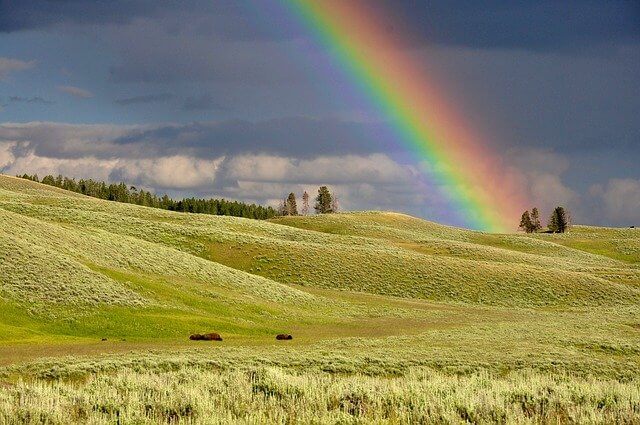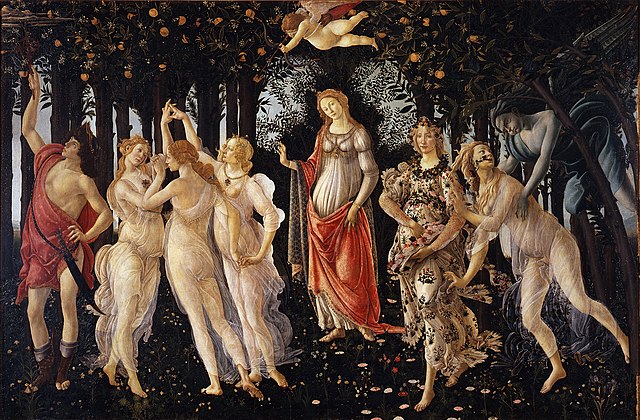
Table of Contents
Who doesn’t love spring? This is the time nature reclaims its vibrant colors and fragrant scents. It’s time to drop the coats, open all doors, and go meet the sun. The season comes around from late March to late June in the Northern hemisphere, and between late September to late December in the Southern hemisphere.
During this time of year, the hours of the night and day are equal but as the season progresses, daytime increases while nighttime decreases. The beauty of spring is that the winter cold has dissipated while the summer heat is not yet scorching. It’s generally a very pleasant time of the year. Spring is a highly symbolic time of the year, with many symbols representing the season.
Symbolism of Spring

Spring is the time of new beginnings, characterized by blooming flowers, the awakening of animals from hibernation to nest and reproduce, the migration of birds towards warmer climates, and is the planting season. Because of these reasons, the season of spring overflows with symbolism. Symbolic themes stemming from spring include:
- Rebirth: Spring is when plants sprout, flowers bloom, birds lay eggs and animals give birth. Basically, spring is the time that nature is reborn. As such, it’s the perfect symbol of rebirth.
- Renewal: It’s during spring that dormant plants and trees begin to come to life. New leaves start to show, flowers bloom, and nature is reinvigorated. It’s symbolic of new beginnings, renewal, and hope.
- Love: When spring comes, people can get out and interact freely. There is no snow blocking roads or doorways. Festivities come alive during spring, hence the love symbolism. During late winter to spring, animals feel the shift in weather and procreate, which further strengthens this association.
- Youth: Spring is vibrant. Everything is fresh and strong. There are also a lot of festivities around this time, which represent youth and freshness.
- Spiritual Rejuvenation: As spring introduces warmth and light, many religions celebrate it by promoting a renewed and positive view of faith. The term “spiritual springtime” has become popular for this reason. For example, during springtime, Christians celebrate Easter, while the Baha’i see spring as a period of refreshment and deep joy.
10 Powerful Symbols Representing Spring

Springtime is represented by several symbols and signs all centered around energy, renewal, love, and warmth.
1. Germanic Symbol of Spring

This Germanic symbol, that was often used in clog almanacs, represents spring, but it also brings to mind three other symbols of spring. These include:
- Sprouts: The curlicues emerging above the circle are a representation of new sprouts coming out from the ground or trees, or new buds emerging from flowers.
- Bunnies: The curlicues also look like bunny ears. Bunnies in themselves are a representation of spring in some cultures and religions.
- Aries: The symbol is used for the horoscopic sign Aries, which is also an indicator of a new astrological year. Aries season is also known as the season for new blooms, positivity, and good vibes.
2. Flowers
During springtime, flowers begin to bloom and landscapes are transformed into colorful, picturesque scenes. They represent new beginnings, beauty, and hope. As flowers bloom, they symbolize the earth’s rebirth after a cold winter.
3. Eggs
Eggs represent fertility, birth, and renewal, all associated with spring. The egg’s enclosed shell protects new life, making it a symbol of the potential that springs forth with the season. Most birds begin to lay eggs in early spring. In ancient times, eggs were a symbol of the goddess Eostre, who represented spring and fertility.
4. Rainbows

Rainbows represent promise, hope, and the blend of sun and rain. After spring showers, rainbows act as reminders of brightness after darkness and the diverse beauty of life. This brings us to our next symbol of spring.
5. Rain
Rain is common during springtime, and represents cleansing, renewal, and nourishment. Spring showers not only nurture the growing plants but symbolize a washing away of the old to make way for the new.
6. Seeds
Seeds represent potential, new beginnings, growth, and hope. During springtime, farmers and gardeners begin to sow their seeds, which grow into food and beautiful ornamental plants. Just as a tiny seed holds the potential for a massive tree, spring represents the immense possibilities that can stem from humble beginnings.
7. Rabbits

Rabbits represent fertility, abundance, and rapid growth. In some countries, like Australia, these cute little animals are considered terrible pests, because of how fast they procreate and the threat they pose to native wildlife.
8. Earthworms
These small, wiggly creatures found in soil lack teeth, eyes, and lungs, but have ten hearts. They’re a prime reason for the fertility of soil, and are so important to the ecosystem. Earthworms aerate the soil, a process extremely vital for the growth and flourishing of plants. In this way, they’re an important aspect of fertility, and by extension, spring.
9. Groundhogs
According to legend, if the groundhog emerges from its burrow on Groundhog Day and sees its shadow (indicating a sunny day), it will be frightened and return to its den, suggesting six more weeks of winter. Conversely, if it doesn’t see its shadow (indicating a cloudy day), it will remain outside, signifying that spring is just around the corner.
The roots of Groundhog Day can be traced back to ancient European weather lore where a badger or sacred bear played the predictive role, rather than a groundhog. The tradition was brought to North America by German immigrants, who settled primarily in Pennsylvania. The groundhog, native to the area, became the new weather prognosticator, and over time, the tradition took hold, growing in popularity.
10. Robins
Robins are a symbol of spring because it’s during this season that many of them return to temperate regions. Sighting a robin, therefore, has become synonymous with the end of winter and the start of spring. These birds are also beautiful little songsters, and hearing them in springtime reinforces their association as a bird of spring.
Spring in Mythology

Greek Mythology
In Greek mythology, the origin of spring is explained through the myth of Demeter and Persephone. Persephone had been abducted by Hades, the god of the underworld, an act that caused her mother Demeter great strife. As she was the goddess of agriculture and fertility, Demeter threatened the earth with famine if her daughter wasn’t returned to her. When she was finally reunited with Persephone, her happiness caused the earth to flourish.
Each year, Persephone is forced to spend six months in the underworld and six months with her mother back on earth. During the time when Persephone is with Hades, Demeter mourns, and the earth experiences winter. When Persephone returns, Demeter rejoices, and spring arrives, leading to the growth of plants and the warmth of summer.
Native American Beliefs
Spring often symbolizes rebirth, renewal, and a return to abundance for Native Americans. For instance, the Lakota Sioux have the “Wakan Tanka”, or Great Spirit, which interconnects all living things, and ceremonies held in spring serve to honor this spirit, hoping for guidance, strength, and abundance in the coming seasons. The Hopi, residing in what is now the southwestern United States, have intricate ceremonies involving Katsinam (spiritual beings) that coincide with the life-giving rains of spring, celebrating the promise of growth and the interconnectedness of life. These traditions show us the profound respect and gratitude Native Americans have historically held for the land and the lessons it teaches.
Ancient Egyptians
Ancient Egyptians had a deep connection to the Nile River and its annual flooding, which was central to their agricultural cycle and understanding of seasons. While their perception of seasons differed from the traditional four-season model familiar to many cultures, the underlying themes of rebirth, renewal, and the cyclicality of life — which are often associated with spring — were deeply rooted in their myths, rituals, and daily life.
The most important myth related to renewal and new beginnings was likely that of Osiris’ return from the dead. Osiris, the god of the afterlife, resurrection, and fertility, played a pivotal role in explaining the cyclical nature of life. He was murdered by his brother Seth but was resurrected by his wife Isis. His rebirth was seen as an eternal cycle, symbolic of the regeneration of the land and the annual flooding of the Nile, which brought fertility and life back to the fields just in time for the growth season (Peret). Osiris’ resurrection mirrors the renewal of spring, symbolizing rebirth and new beginnings.
Japanese Buddhist Beliefs
The Japanese Buddhists celebrate both the spring and fall equinox by returning to their ancestral homes to pay respect to their ancestors. This festival is known as Higan, a name that means, “From the other shore of the Sanzu River”. The Buddhist believe that crossing the Sanzu, which is a mystical river, means crossing into the afterlife.
Spring Symbolism in Literature and Art

Spring has been used in art, literature, and music throughout history to represent various themes. Generally, these themes are related to spring symbolism, such as renewal, rebirth, and the impermanence of life.
In literature, spring is often used to represent the emotional or moral awakening of characters. Classical poets like Geoffrey Chaucer opened “The Canterbury Tales” with the return of spring, describing the rejuvenating rains, the zodiac’s movement, and the spirited flowers, clearly linking the renewal of the land with the pilgrims’ spiritual journey.
In the same way, Shakespeare’s sonnets, like Sonnet 98, draws on the motifs of spring to muse on youth, love, and fleeting beauty. When these themes are extrapolated upon, readers are reminded of the cyclical nature of life and the inexorable march of time, where spring, representing youth and vigor, eventually gives way to the inevitable winter, or the decline.

What about visual art? We know that spring has been a favorite among painters, serving as both a literal subject and a symbolic motif. The Renaissance era, with its emphasis on rebirth and rediscovery, often depicted spring as an allegory for love and fertility. One clear example is Botticelli’s iconic “La Primavera,” which literally means The Spring, where the lushness of the landscape and the vivacity of its characters capture the essence of spring’s vitality.
Impressionist painters, like Claude Monet, gravitated towards the transformative power of spring, capturing the play of light and color on blossoming landscapes, conveying a sense of fleeting beauty and momentary wonder.
In music too, we see spring has inspired musical compositions. From Vivaldi’s lively “Spring” to The Beatles’ hopeful “Here Comes the Sun,” there are beautiful pieces that represent the joy of spring.
Wrapping Up
There are many myths and stories that seek to explain the changing seasons of the year. Whether you subscribe to one of these cultural stories or prefer to go the scientific way, one thing is clear, spring is the time for renewal and rebirth. This is the time to appreciate nature and initiate new beginnings.
Related articles
Powerful Symbols and Symbolism of Summer
Winter Symbols and Symbolism to Celebrate the Cold Season
Autumn (Fall): Powerful Symbols and Symbolism








